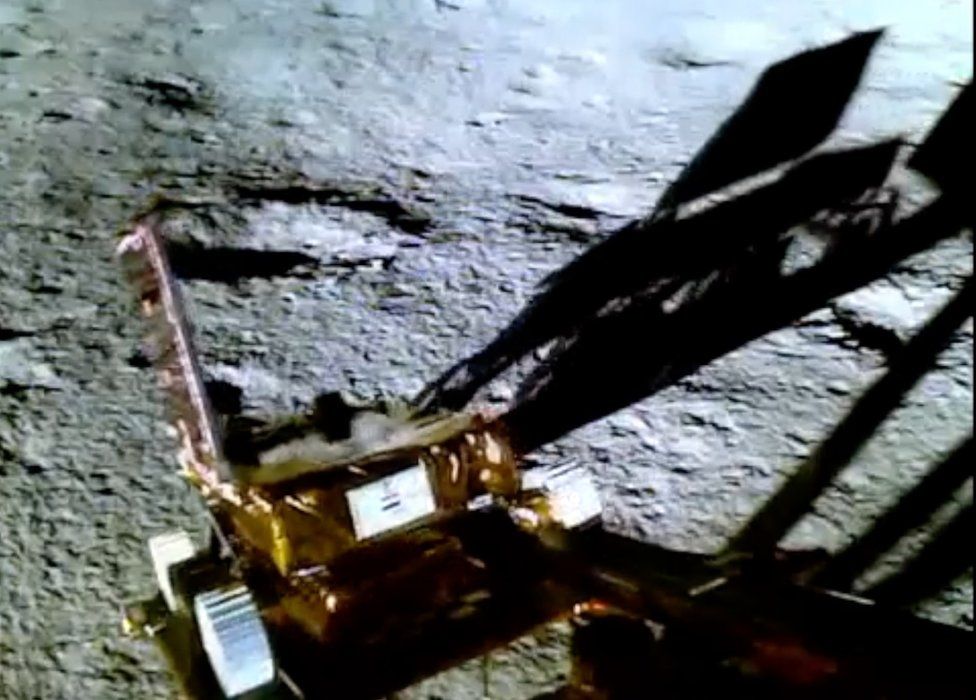Exactly a week ago, India set down a robotic probe on the Moon, becoming the first country to land near the lunar south pole.
Chandrayaan-3’s Vikram lander – carrying a rover in its belly – touched down on the lunar soil after a 20-minute, nail-biting finale watched by millions of people across the world.
Hours later, the Pragyaan rover – Pragyaan is the Sanskrit word for wisdom – exited the lander and took its first steps on the Moon.
The Indian space agency has been providing regular updates on the rover’s findings, the distance it is covering and how it is negotiating the obstacles in its path.
Here’s a look at the highlights from the first week of the rover’s Moonwalk:
Sulphur finds
On Tuesday evening, Isro said that a laser detector onboard had made “the first-ever in-situ – in the original space – measurements on the elemental composition of the surface near the south pole” and found a host of chemicals, including sulphur and oxygen, on lunar soil.
The instrument “unambiguously confirms” the presence of sulphur, it said, adding that preliminary analysis also “unveiled the presence of aluminium, calcium, iron, chromium, titanium, manganese, silicon and oxygen”.
“A thorough investigation regarding the presence of hydrogen is underway,” it added.
Noah Petro, a project scientist at Nasa, told the BBC’s Soutik Biswas that it’s been known from the 1970s – from the Apollo and Luna samples – that sulphur is present in the lunar soil.
But he described Pragyaan’s findings as “a tremendous accomplishment”.
“I think Isro is highlighting that it’s in-situ – so it’s important to have measured sulphur on the lunar surface. Sulphur is a volatile element if it’s not inside a mineral. So, if it’s not part of a crystal, it’s very cool to see it measured on the surface,” he added.
Negotiating craters
As the rover roams around the mission’s landing point – now named the Shiv Shakti Point – in what Isro has described as “the pursuit of lunar secrets”, it has covered quite a distance. It has also had to change course to stay safe because of deep craters.
Two days after the landing, Isro said Pragyaan – which travels at a speed of 1cm per second – had “successfully traversed a distance of 8 metres (26ft)”.



It added that on Sunday, the rover had encountered a crater with a diameter of four metres. But it was spotted well on time – when Pragyaan was about three metres away.
“It was commanded to retrace the path. It’s now safely heading on a new path,” Isro added.
Photos released by the space agency show the crater and the footprints of the rover on the lunar soil – going forward and returning.
Taking the Moon’s temperature
On Sunday, Isro said that they had received the first set of data about the temperatures on the lunar topsoil and up to the depth of 10cm below the surface from a probe onboard Vikram lander.
The probe – called the ChaSTE experiment, or Chandra’s Surface Thermophysical Experiment – is fitted with 10 individual temperature sensors and has thrown up some interesting results.
A graphic posted on X (formerly Twitter) by Isro showed a sharp difference in temperatures just above and below the surface.
The BBC is not responsible for the content of external sites.
Allow Twitter content?
This article contains content provided by Twitter. We ask for your permission before anything is loaded, as they may be using cookies and other technologies. You may want to read Twitter’s cookie policy and privacy policy before accepting. To view this content choose ‘accept and continue’.
The BBC is not responsible for the content of external sites.

While the temperature on the surface was nearly 60C, it plummeted sharply below the surface, dropping to -10C at 80mm (just about 3 inches) below the ground.
An Isro scientist told the news agency PTI that he was “surprised” by the temperature fluctuation. “We all believed that the temperature could be somewhere around 20C to 30C on the surface but it is surprisingly higher than what we had expected,” BH Darukesha said.
The Moon, however, is known for harbouring extreme temperatures – according to Nasa, daytime temperatures near the lunar equator reach a boiling 250F (120C), while night temperatures can plunge to -208F (-130C).
The Moon’s poles, it says, are even colder – one crater near the north pole recorded -410F (-250C) which makes it the coldest temperature measured anywhere in the entire solar system. Equally cold temperatures have been recorded at some of the craters which remain permanently in the shadows in the south pole
BBC News India is now on YouTube. Click here to subscribe and watch our documentaries, explainers and features.

Read more India stories from the BBC:
- India lodges ‘strong protest’ over new China map
- Putin tells India PM Modi he won’t attend G20 summit
- The pain of Gurkhas over Indian army’s new hiring plan
- ‘I saw our house falling down the hill’
- Iconic India restaurant in UK to shut after 70 years

